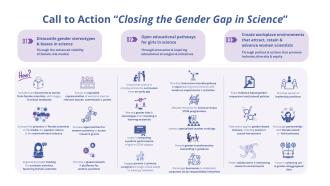
2019 was an exciting year for science as ever. We have collated the top ten stories that was popular on Research Matters in 2019. These were the ones that garnered most views because of readers like you. Interestingly, the top-two have been about awards received by #WomeninScience! We would like to thank you for patronage and look forward to your support in the years to come.
1. Two Bengaluru scientists shine on the list of 2019 Padma awardees
Prof Rohini M. Godbole and Prof Sharada Srinivasan, two Bengaluru-based scientists, were among those conferred with the prestigious Padma Shri award announced by the Ministry of Home Affairs, Government of India. Prof Rohini Godbole is a Professor at the Centre for High Energy Physics, Indian Institute of Science. Prof Sharada Srinivasan is a Professor at the National Institute of Advanced Studies (NIAS), Bengaluru.
2. Mathematician Dr Neena Gupta shines as the youngest Shanti Swarup Bhatnagar awardee
Dr Neena Gupta, Associate Professor at the Theoretical Statistics and Mathematics Unit of the Indian Statistical Institute (ISI), Kolkata, has been awarded the Shanti Swarup Bhatnagar Prize 2019, in the field of Mathematical Sciences. This prize, one of the most prestigious awards in the country for research in Science, honours scientists for significant and cumulative contribution to their area of research. Dr Gupta, the youngest person in Mathematical Sciences to receive this award till date, has been recognised for her contributions to affine algebraic geometry, especially in proposing a solution to the Zariski Cancellation Problem.
3. Welcome AJIT, a ‘Made in India’ Microprocessor
In an attempt to make a mark in the highly competitive segment of microprocessor manufacturing, engineers from the Indian Institute of Technology Bombay (IIT Bombay) have developed a new microprocessor called AJIT—the first ever microprocessor to be conceptualised, designed, developed and manufactured in India. This innovation could not only reduce the country’s imports but also make India self-reliant in electronics.
4. High blood pressure? It could be in the air!
Previous studies have indicated a positive correlation between blood pressure and long-term exposure to tiny particulate matter present in the air. However, they are limited to high-income countries, and their findings cannot be extrapolated to low and middle-income countries such as India. In these countries, there are significant differences in the genes, lifestyle and environment compared to high-income countries. A study published in the journal Epidemiology, aims to fill this gap by examining associations between long-term exposure to ambient particulate air pollution, and prevalence of hypertension in adults from peri-urban India.
Tracing history is a tedious task. We decipher millions of clues along the way before getting to what we seek. Sometimes, nature is benevolent and throws up an entire book of history right in front—a history of not just a few centuries, but of millions of years! That's what happened when a group of herpetologists bumped into a vine snake, which they now call Proahaetulla antiqua. The team of researchers, from the Indian Institute of Science, Bengaluru were attempting to study and classify snakes in the Western Ghats systematically. That's when they came across Proahaetulla antiqua, which is endemic to the southern Western Ghats. What's more interesting is that it is an ancient species, thought to have evolved around 26 million years ago during the mid-Oligocene.
6. Watch what you eat: 1 in 5 deaths due to poor diet, reveals study
A global study finds that diets high in sodium and low in whole grains and fruits result in most deaths. Now, a study published in The Lancet, by researchers from the GBD 2017 Diet Collaborators, has raised the alarm on the need to change our eating habits. The study has found that globally, one in five deaths in 2017 were associated with poor diet. Cardiovascular diseases, followed by cancers and type 2 diabetes were the leading killers.
7. Alternatives to stubble burning not only possible but profitable, shows study
In 2017, researchers from The Nature Conservancy (TNC), an environmental organisation headquartered in the US, met with a few collaborators from different institutes in India, to discuss this ‘burning’ problem and find alternatives to the practice. In a new study, Dr Shyamsundar and her collaborators from India, Mexico and the USA, have evaluated the impact of alternative practices to stubble burning on the environment, and their profitability. The analysis, published in the journal Science, finds that using Happy Seeder—a machine that can sow wheat in the presence of rice straw—is profitable for farmers and can also help the environment.
8. Cutting Pesticide Costs in Cotton Farms
In a study, researchers at the Indian Institute of Technology Bombay, Indian Institute of Management Nagpur, and Jawaharlal Nehru University, New Delhi, have analysed available data on pesticide usage to study changes in pesticide expenditure among cotton farmers in India and reported how it differs according to factors such land size, ownership and irrigation.
9. IISc Develops India’s first e-mode Gallium-Nitride Power Transistor
A group of faculty members at IISc have developed India’s first-ever e-mode gallium nitride power transistor, whose performance is comparable to some of the best reports till date. This interdisciplinary team of investigators spread across three departments (Department of Electronic Systems Engineering, Department of Electrical Engineering and Center for Nano Science and Engineering).
10. Hearing out the deaf: IISc researchers design a smartphone-based therapy and hearing aid
About 6 in every 1000 children screened in the world are born deaf, and for every 200 of them, only one speech therapist is available. The situation is even worse in countries like India, where most people are poor, and health services are not readily available. In a recent study, a group of researchers from the Indian Institute of Science (IISc), Bengaluru, have designed a hearing aid that can offer substantial support, especially in the Indian context. The study, published in the Proceedings of IEEE Global Humanitarian Technology Conference, emerged from a course project at IISc, with intellectual contributions from Dr Ramesh A and Ms. Littina George Manalel, St. John’s Medical College, Bengaluru.
















